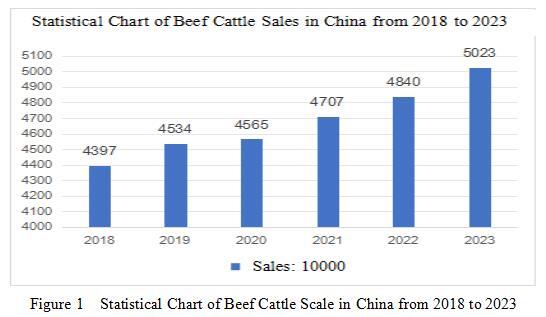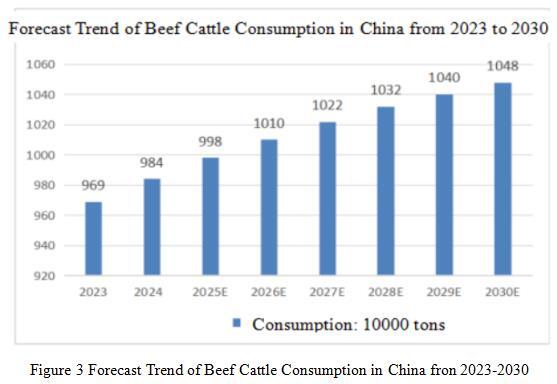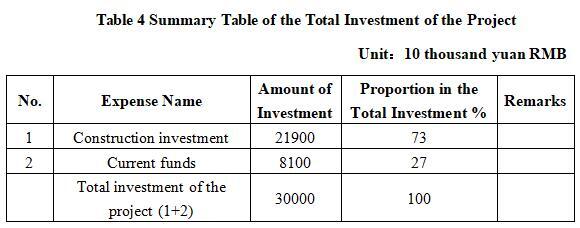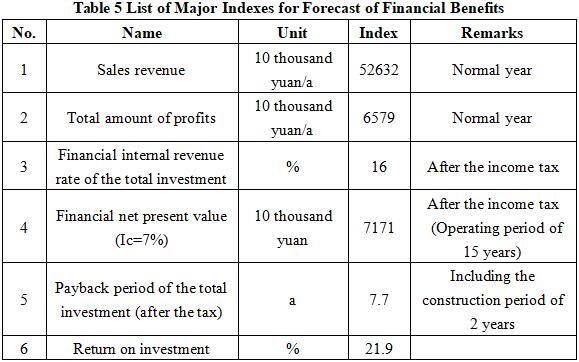Processing of Agricultural Products and Food
Standardized Beef Cattle Breeding Demonstration Farm Project of Jilin City
1. Introduction to the Project
1.1 Project background
1.1.1 Product introduction
The project covers an area of 500000 square meters and will produce 10000 beef cattle annually after completion.
In 2019, “Huadian Yellow Cattle” was selected as a regional public brand for agricultural products in the China Agricultural Brand Catalog; in 2020, Huadian City was recognized as the “Huadian Yellow Cattle” advantageous area for Chinese characteristic agricultural products.
During the grass feeding period of 10-18 months and the grain feeding period of 500 days, Huadian yellow cattle will have fat deposited between the fibrous tissues of their muscles, forming red and white striped meat resembling marble. This type of beef weighs 200 grams and is sold for 70-80 yuan in the market. Good quality has given “Huadian Yellow Cattle” considerable market competitiveness.
The project is different from traditional breeding projects in the past. It will provide customized breeding services, such as adoption, according to the needs of consumers. At the same time, it will cooperate with rural tourism and scenic spots in Jilin City to provide appreciation and specialty beef.
1.1.2 Market prospect
(1) Market situation of the beef cattle industry
As an important component of animal husbandry, the beef cattle industry mainly focuses on the breeding, slaughtering, processing, and sales of beef cattle. With the changes in global meat consumption structure and the increasing health awareness of consumers, beef, as a low-fat and high protein healthy food, continues to have a growing market demand. In China, with the rapid development of the economy and the improvement of residents’ living standards, the demand for beef has been increasing year by year, promoting the rapid development of the beef cattle breeding industry.
From a global perspective, beef cattle are mainly distributed in Asia (39%), India (30.3%), South America (30.1%), and Brazil (26.1%). The top ten countries for global beef cattle slaughter are China, India, Brazil, the United States, the European Union, Argentina, Mexico, Russia, Australia, and New Zealand. The top ten countries in terms of global beef production are the United States, Brazil, the European Union, China, India, Argentina, Mexico, Australia, Canada, and Russia. In terms of beef consumption, the global per capita consumption is 4.4 kg/year, of which the per capita consumption of beef in Argentina is 64 kg/year, while that in China is less than 10 kg/year.
From a national perspective, China’s beef cattle breeding has formed four advantageous beef cattle production areas: Central Plains, Northeast China, Southwest China, and Northwest China. At present, beef cattle breeding in China is mainly concentrated in the southwest region represented by Yunnan, Guizhou and Sichuan, the northwest region represented by Xinjiang, Gansu, and Qinghai, and the northeast region represented by Heilongjiang, Jilin, Liaoning, and Inner Mongolia. With the rapid improvement of China’s economic level, rising labor costs, and increased environmental policies, the distribution of beef cattle breeding industry has undergone changes. Overall, China’s beef cattle breeding industry is showing a trend of gradually shifting from the original advantageous areas in the Central Plains to the advantageous areas in the northeast, northwest, and southwest.
China is a major global producer of beef cattle and beef. In recent years, the number of beef cattle slaughtered in China has continued to increase, providing a solid foundation for the stable development of the beef cattle industry. The Research Briefing on the Prospects and Strategic Investment Opportunities of China’s Beef Cattle Breeding Industry from 2025 to 2030 released by China Academy of Commerce Industry Research shows that in 2023, the national beef cattle output will reach 50.23 million heads, an increase of 1.83 million heads from the previous year, a growth of 3.8%, the highest output since 2017, and it will increase year by year, exceeding 50 million heads for the first time.

With the improvement of beef cattle breeding technology and production management, China’s beef production continues to grow. According to the Research Briefing on the Prospects and Strategic Investment Opportunities of China’s Beef Cattle Breeding Industry from 2025 to 2030 released by the China Business Industry Research Institute, the national beef production in 2023 was 7.53 million tons, an increase of 4.8% compared to the previous year.

(2) Market situation of the beef cattle industry
Since June, 2024, the average wholesale price of beef in the national agricultural product wholesale market has dropped to around 61 yuan per kilogram, a significant decrease from previous years. This change not only reflects the adjustment of market supply and demand, but also exposes problems such as overcapacity and large price fluctuations in the beef cattle industry. Despite the current sluggish market, China’s beef cattle industry still has a huge market size and broad development space.
The Chinese government attaches great importance to the development of the beef cattle industry and has introduced a series of supportive policies. For example, providing financial subsidies, financial support, and technical training has provided strong guarantees for the rapid development of the beef cattle industry. Some regions, such as Yangxin County in Shandong Province, have formed beef cattle industry clusters. These regions have complete industrial supporting facilities and abundant industrial resources, providing strong support for the development of the beef cattle industry.
The variety of beef cattle raised in China is gradually becoming more abundant, including introduced breeds such as Simmentaler cattle, Charlolais cattle, Limousin cattle, as well as local breeds such as Nanyang cattle and Luxi cattle. These varieties each have their own characteristics, providing the market with a diverse range of beef products. With the advancement of technology, beef cattle breeding techniques are constantly improving. For example, the application of technologies such as optimizing feed formulas, enhancing disease prevention and control capabilities, and improving breeding environments has improved the survival rate and meat production performance of beef cattle.
From the perspective of beef consumption, with the changing and upgrading of people’s meat consumption structure, the demand for beef consumption is growing rapidly. However, due to factors such as the long breeding cycle, high production costs, and outdated development methods of domestic beef cattle, the country has long relied on imports to fill the huge demand gap, with imported beef accounting for about 30% of total consumption. Driven by the gradual release of domestic market potential and the continuous upgrading of consumption structure, beef, as an important source of high-quality protein, will maintain stable growth in consumer demand.
From the perspective of consumption prospects, driven by the gradual release of domestic market potential and the continuous upgrading of consumption structure, beef and mutton, as an important source of high-quality protein, will maintain stable growth in consumer demand and continue to increase in proportion to meat consumption. It is expected that by 2030, China’s beef consumption will have reached 10.48 million tons, with an average annual compound growth rate of 1.13%.

(3) Current situation of the beef cattle industry in Jilin Province
In the first half of 2024, the number of beef cattle raised in Jilin Province reached 6.044 million, a year-on-year increase of 12%, with a growth rate 14 percentage points higher than the national average, ranking first among the three northeastern provinces; the slaughter volume reached 221000 heads, a year-on-year increase of 123%; the output value of the entire beef cattle industry chain reached 120.57 billion yuan, a year-on-year increase of 9.1%. By now, “Jilin Cattle, China’s Cattle” has not only established a full chain industrial system covering breeding, breeding, trading, slaughtering and deep processing of high-quality breeds, but also leads the country in terms of total scale, quality standards, and breeding source construction.
For many years, although Jilin has been an important “meat warehouse” in China, the beef cattle industry chain is short, and most beef cattle are sold by transporting live animals, which not only has low added value but also weak ability to resist market risks. Jilin Province is market-oriented and strengthening technological support to help upgrade the industrial chain.
Seize the advantage of breeding sources. As a national core breeding farm for beef cattle, Jilin Xinmu Technology Co., Ltd. applies new technologies such as embryo transfer to supply nearly a thousand breeding cattle embryos and millions of high-quality frozen semen to the market every year. Jilin Province has established a Beef Cattle Seed Industry Innovation Center based on scientific research institutions to carry out technological research and development in the cultivation and quality improvement of characteristic populations such as Yanbian yellow cattle, grassland red cattle, and Woking black cattle.
Jilin encourages enterprises to develop slaughter and processing, and promotes the construction of cold chain storage facilities through the policy of increasing slaughter rewards. Sixteen policy funds directly reach enterprises, research units, etc., guiding enterprises to research and develop, expand deep processing, and extend the industrial chain. With the integration of the tertiary industry as the engine, Jilin’s beef cattle industry has upgraded from “selling live cattle” to the entire industry chain.
1.1.3 Technical analysis
The gathering of beef cattle breeding enterprises in Jilin Province, with advanced, mature, and stable project design and construction technology, can ensure the smooth implementation of the project.
1.1.4 Advantageous conditions of project construction
(1) Policy advantages
The Notice on Promoting the Stable Development of Beef and Dairy Cattle Production proposes to accelerate the implementation of the basic cow expansion and quality improvement project, and to provide active support to farmers who raise basic cows for beef cattle and select excellent breeding bulls for frozen semen breeding through the method of “increasing first and then supplementing, and meeting calves to supplement cows”. On the basis of stabilizing the number of basic cow populations, the breeding performance and reproductive efficiency of cows will be improved; it will promote the integrated development of primary, secondary, and tertiary industries. Modern agricultural industrial parks and advantageous characteristic industrial clusters projects led by beef cattle and dairy industry constructed in various regions will further strengthen support for the development of the entire industry chain of forage collection, storage, breeding, slaughtering, and processing. Combined with local conditions, more precise and effective support will be given to the forage collection, storage, and breeding links to promote industrial upgrading and increase the income of farmers and herdsmen.
In September, 2021, Jilin Provincial Government issued the Opinions on Implementing the Straw to Meat and Ten-million Beef Cattle Construction Project, which stated that by 2025, the province aims to have achieved a 10-million beef cattle breeding scale, including 6 million in stock and 4 million sold; the output value of the entire beef cattle industry chain has reached 250 billion yuan.
The Opinions of the People’s Government of Jilin Province on Accelerating the Development of the Agricultural Product Processing Industry and Food Industry mentioned that it is necessary to tap into the advantages of brands such as “Yanbian Yellow Cattle” and “Grassland Red Cattle”, consolidate the development of slaughtering and processing, cooked food processing, accelerate the extension of industrial chains such as leather products and biopharmaceuticals, and increase added values.
The Implementation Opinions on Supporting the Development of the Whole Industry Chain of Beef Cattle in Huadian City (Trial) clearly states that with the goal of “extending, supplementing, and strengthening the chain”, we will accelerate the construction of national level standardized demonstration zones for the whole industry chain of beef cattle, accelerate the transformation of beef cattle counties into strong counties, and achieve high-quality development of the beef cattle industry. By the end of 2025, the total number of beef cattle raised in the city is expected to have reached 370000 and the output value of the entire beef cattle industry chain has reached 4.5 billion yuan.
The Implementation Plan for Optimizing the Investment Promotion Mechanism in Huadian City proposes to establish specialized investment promotion teams for five industrial chains: mineral processing, new energy and new materials, modern agriculture, medicine and health, ecotourism, and ice and snow. Special actions will be carried out to optimize and improve the business environment, and the optimization and improvement of the “environment of six aspects” of government affairs, market, elements, rule of law, openness, and credit will be implemented. All matters will be accessible online, and the occupancy rate of government service centers will reach 99.24%.
The Work Plan for the “Four in One and Five Joint Guarantees” Project Construction in Huadian City proposes to clarify the work tasks of a special service team with city-level leaders as “secretaries general”, and select deputy-township bureau level or above leaders who understand the business, have strong abilities, and a sense of responsibility to serve as project secretaries to lead and handle the preliminary procedures of the project. From the start of project construction to completion and production, high-standard, comprehensive, and deep-level guarantee services will be carried out.
(2) Resource advantages
Huadian City will continuously optimize its industrial structure in 2023. The three dominant industries of soybeans, sweet glutinous corn, and beef cattle have strong growth momentum. The planting area of soybeans increased by 40.6%, the processing capacity of sweet glutinous corn reached 110 million ears, and the number of beef cattle raised reached 300000, an increase of 14.06%. In the first half of 2024, Huadian City will prioritize the development of agriculture and rural areas, with a total planting area of 1.94 million mu of grain crops in the city.
The total supply of state-owned construction land in Huadian City is planned to be controlled at 224.56 hectares in 2024. In the total planned supply, there are 10.57 hectares of commercial land, 76.42 hectares of industrial and mining storage land, 19.48 hectares of residential land, 4.5 hectares of public management and public service land, 113.59 hectares of transportation land, 453121.93 hectares of forest land, 6.7967 million mu, and 938.53 hectares of grassland, 14100 mu. Huadian has scarce arable land, but abundant forest resources, with grazing customs dating back a hundred years.
Huadian City has a large stock of exploitable land resources, and newly added and reserved land can meet the needs of new projects. Land prices are at a low level among 41 cities in Northeast China.
(3) Talent advantages
Jilin City has universities such as Northeast Electric Power University, Jilin Institute of Chemical Technology, Beihua University, Jilin Agricultural Science and Technology College, Jilin Medical College, Jilin Electronic Information Vocational and Technical College, Jilin Industrial Vocational and Technical College, Jilin Railway Vocational and Technical College, Jilin General Aviation Vocational and Technical College, etc. These universities provide a continuous supply of talent support for production enterprises. These talents not only possess rich practical experience, but also have high technical level and innovation ability. They are able to solve various technical problems in the production process, improve production efficiency and product quality. At the same time, these professional skilled talents can actively participate in the technological innovation and product research and development work of the enterprise, providing strong guarantees for the sustainable development of the enterprise.
At the same time, Jilin City has a large number of high-quality industrial workers. After training by enterprises and public welfare institutions, more than 10000 skilled talents are sent to the society every year, and more than 20000 people of various types are trained for the society.
The proportion of skilled workers in the Northeast urban agglomeration is at a relatively high level, and the labor force is in a dividend period. The labor cost is relatively low, which can meet the needs of various enterprises.
(4) Location and transportation advantages
Huadian City has formed a well connected transportation network, 67 kilometers west of Panshi City, 110 kilometers north of Jilin City, and 240 kilometers away from Changchun City, the provincial capital. 663 highways have been built, with a total length of 3188.58 kilometers (including 274 high-grade roads and 1198.91 kilometers). Among them, there are 3 provincial trunk lines with a total length of 264.44 kilometers (3 high-grade road surfaces with a total length of 174.26 kilometers); there are 4 city (county) level highways with a total length of 202.57 kilometers (4 high-grade roads with a total length of 188.13 kilometers); 64 dedicated highways with a total length of 795.46 kilometers (including 2 high-grade roads with a total length of 18 kilometers); there are 91 township level highways with a total length of 763.61 kilometers (70 high-grade roads with a total length of 543.4 kilometers); there are 501 village level roads with a total length of 1162.5 kilometers (195 high-grade roads with a total length of 275.12 kilometers).
1.2 Contents and scale of project construction
1.2.1 Construction scale
The total area of the project is 500000 square meters. After the project reaches the production capacity, 10000 beef cattle will be slaughtered annually.
1.2.2 Construction contents
The total construction area of the project is 110000 square meters, including a 100000㎡ cowshed, a 10000㎡ employee dormitory and office buildings, and the automated feeding, water supply, and manure cleaning facilities as well as intelligent monitoring equipment for weight, diseases, estrus, etc. will be purchased.
1.3 Total investment of the project and capital raising
1.3.1 Total investment of the project
The total investment of the project is 300 million yuan, including the construction investment of 219 million yuan and current funds of 81 million yuan.

1.3.2 Capital raising
Self-financing by the enterprise
1.4 Financial analysis and social evaluation
1.4.1 Main financial indexes
After the project reaches the production capacity, its annual sales revenue will be 526.32 million yuan, its profit will be 65.79 million yuan, its investment payback period will be 7.7 years (after the tax, including the construction period of 2 years) and its return on investment will be 21.9%.

Note: “10 thousand yuan” in the table is in RMB.
1.4.2 Social evaluation
After the completion of the project, the standards for large-scale breeding will be raised to ensure quality and create a brand, and to end the inconsistent breeding standards among individual farmers. This will enable thousands of small-scale production households to enter an orderly development track and increase economic benefits. The project construction has a driving and promoting effect on the agricultural and animal husbandry industry in Jilin Province, and is also conducive to the implementation of the rural revitalization strategy.
1.5 Cooperative way
Joint venture or cooperation, and other methods can be discussed face-to-face.
1.6 What to be invested by the foreign party
Funds, and other methods can be discussed face-to-face.
1.7 Construction site of the project
Sunjiatun Village, Yongji Neighborhood, Huadian City
1.8 Progress of the project
It is attracting foreign investment.
2. Introduction to the Partner
2.1 Basic information
Name: Huadian People’s Government
Address: Huadian City, Jilin City, Jilin Province
2.2 Overview
Huadian City has one provincial-level economic development zone, five streets, nine townships, and a total population of approximately 341300 people. The city’s population is mainly Han Chinese. In March, 2001, it was designated by Jilin Municipal Government as a pilot project for building medium-sized cities and granted partial prefecture level management authority.
The urban area of Huadian City is located on the Huifa River in the southwest central part of Huadian City. The terrain of the city is flat, surrounded by mountains, and the transportation is convenient. It is the political, economic, and cultural center of the city, with a built-up area of 15 square kilometers.
The Economic Development Zone is located in the northwest of the city, with a planned area of 6.29 square kilometers and jurisdiction over 7 administrative villages.
In 2023, Huadian City achieved a regional GDP of 11.22 billion yuan, an increase of 8.3% over the previous year. Among them, the added value of the primary industry was 3.54 billion yuan, an increase of 4.1%; the added value of the secondary industry was 2.72 billion yuan, an increase of 18.4%; the added value of the tertiary industry was 4.97 billion yuan, an increase of 7%. The ratio of the three industrial structures is 31.5:24.2:44.3.
2.3 Contact method
Postal code: 132000
Contact person: Zhang Hao
Tel: +86-432-66221983
+86-13331700111
E-mail: swjxmk66221983@163.com
Contact method of the city (prefecture) where the project is located:
Contact unit: Investment Promotion Service Center of Jilin Municipal Bureau of Commerce
Contact person: Jiang Yuxiu
Tel: +86-432-62049694
+86-15804325460
E-mail: jlstzcjfwzx@163.com


